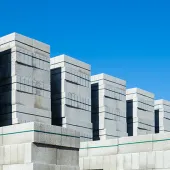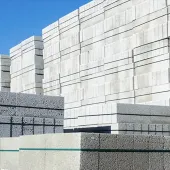Competition Commission looks to break open cement market

Competition Commission publishes summary of provisional findings in market investigation into supply of aggregates, cement and ready-mixed concrete in Great Britain.
THE Competition Commission (CC) is lining up a wide range of measures to break open the cement market in Great Britain (GB), after provisionally finding that both structure and conduct in the sector limit competition by aiding co-ordination between certain UK producers.
The CC has today [21 May] published a summary of its provisional findings in its market investigation into the supply of aggregates, cement and ready-mixed concrete (RMX) in GB. The CC has provisionally concluded that co-ordination between the three major cement producers (Lafarge Tarmac, CEMEX and Hanson) in the cement market is likely to be resulting in higher prices for all cement users.
The CC’s finding does not relate to explicit collusion between these producers. Rather, as the cement market is highly concentrated with only four GB producers (Hope Construction Materials (HCM) being a new entrant), who have an unusually high level of understanding of each other’s businesses – this has created conditions which allow three of them to co-ordinate their behaviour, thereby softening competition and resulting in higher prices for consumers.
The CC is now looking at a wide range of possible remedies to increase competition in the cement market, including requiring the major producers to divest cement plants (and RMX operations as part of the remedy to co-ordination in cement); the creation of a cement buying group; prohibiting generalized price announcement letters to customers; and restrictions on making available other information which can aid co-ordination.
Professor Martin Cave (pictured), CC deputy chairman and chairman of the Inquiry Group, said: ‘We have provisionally found some serious problems with the way the cement market operates in GB. In a highly concentrated market where the product doesn’t vary, the established producers know too much about each other’s businesses and have concentrated on retaining their respective market shares rather than competing to the full. Strikingly, despite low demand for cement over recent years, prices and profitability for the GB producers have still increased.
‘There are only four cement producers in the UK and one of those is a new entrant to the market. This concentration – and the close links between the producers at many levels – along with industry practice, has for a long time given GB producers detailed awareness of how their counterparts are performing, as well as of their future pricing strategy.
‘Established information channels such as price announcement letters can signal their plans, and tit-for-tat behaviour and cross-sales can be used to prevent or retaliate against any moves to disturb the overall balance between the different players in this market. They have also been in a position to increase the already significant barriers that exist for new entrants.
‘Our finding does not mean they are explicitly colluding or operating a cartel because there are already several ways of communicating each other’s intentions without the need for specific discussions.
‘Given the extent of the problems we have found, we feel that hard-hitting measures may be necessary to open up the cement market to greater competition by transforming existing structures and behaviour. The fundamental importance of this product to construction and building and the amount of such work that is funded by the public purse only underlines the need for these actions. Our initial assessment is that these problems could have cost GB consumers around £180 million over the period 2007 to 2011, and we also believe this could be an underestimate.’
Aggregates are the granular base materials used in the construction of roads, buildings and other infrastructure. Cement is the ‘glue’ that binds together the components of building materials. Among other uses, cement is mixed with aggregates and water to produce RMX. RMX is concrete that is produced in a freshly mixed and unhardened state. RMX is manufactured from cement, aggregates, water and other additives as necessary.
There are five major producers of heavy building materials in the UK: Aggregate Industries, CEMEX, Hanson, HCM and Lafarge Tarmac. HCM is a new firm established in January 2013 after it bought cement, aggregates and RMX assets which the CC had required Anglo American (the owner of Tarmac) and Lafarge to divest following an inquiry into the Anglo American/Lafarge joint venture last year. Aggregate Industries does not produce cement in the UK but all five have significant RMX operations.
The CC has not identified any problems with the markets for aggregates or RMX.
The CC has provisionally found that there was a combination of structural and conduct features that gave rise to an adverse effect on competition (AEC) in the GB cement markets. The structural features are:
- high market concentration;
- transparency of sales and production shares, wins and losses and customer–supplier relationships;
- high barriers to entry (including limits to the constraint imposed by imported cement);
- homogeneity of product;
- customer characteristics and behaviour (in particular, regularity of purchases, purchases at fixed locations, concentration of customer base and single sourcing for a particular job site); and
- vertical integration from cement into downstream operations.
The conduct features are:
- a strategic focus on maintaining market stability between the members of the co-ordinating group, frequently manifested in a focus on maintaining existing (or returning to pre-existing) relative shares of sales;
- price announcement behaviour (which facilitates price leadership and price following, and softens customer resistance to price increases);
- tit-for-tat behaviour used to balance shares and for retaliation;
- use of cross-sales as a mechanism for transparency, signalling and, on occasion, share balancing and retaliation; and
- attempts to target importers beyond normal competition on price and service.
The CC also found an AEC as a result of contracts involving certain major producers for the supply of granulated blast-furnace slag (GBS) and for the supply of ground granulated blast-furnace slag (GGBS). GGBS can be used as partial substitute for cement.
The possible remedies include:
- divestiture of cement production capacity by one or more of the top three cement producers;
- divestiture of RMX plants by one or more of the top three cement producers;
- the creation of a cement buying group or groups;
- prohibition on GB cement producers sending generalized cement price announcement letters to their customers;
- restrictions on the disclosure of cement market data by the UK Government and by GB cement producers to private sector organizations;
- recommendations to the UK Government/European Commission on the publication of GB cement producers’ verified emissions data under the EU Emissions Trading Scheme; and
- structural measures to address the AEC in relation to GGBS/GBS production in GB.
The provisional findings summary, notice of possible remedies and all other information relating to the investigation are available on the investigation home page. The full provisional findings report will be published shortly.
The CC is required to publish its final report by 17 January 2014 and will now invite responses. Any interested party is invited to respond to the provisional findings and notice of possible remedies by 12 June 2013.
To submit evidence, email: aggregates@cc.gsi.gov.uk; or write to: Inquiry Manager, Aggregates Market Investigation, Competition Commission, Victoria House, Southampton Row, London WC1B 4AD.









